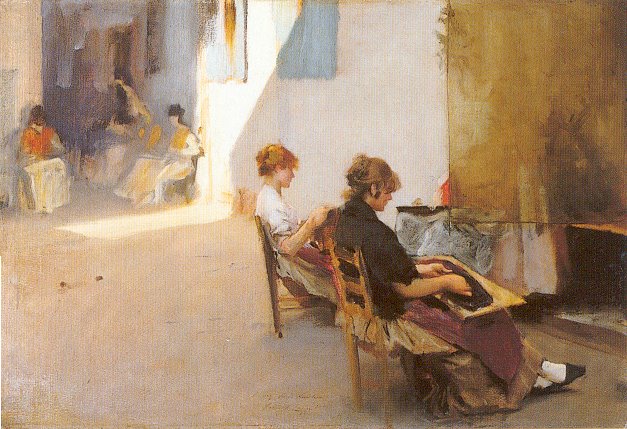The
Bead Stringers of Venice
John
Singer Sargent
-- American painter
1880-82
National
Gallery of
Ireland, Dublin
Oil on
canvas laid on
board
56.2 x
81.9 cm (22 1/8
x 32 1/4 in.)
5th
Baron Cloncurry
bequest, 1929 NGI921
Jpg: friend of
the JSS Gallery
The painting, an
unfinished sketch,
shows bead stringers assembling the beads as they sit outside in a
small
alley or corridor. The two nearest women face an open door, possibly a
bead shop similar to what Sargent painted in Venetian Glass Workers
(thumbnail). Apparently whatever he was planning for the doorway, he
grew frustrated and scraped, or literally cut it away, taking part of a
woman leaning against the wall with it. (1)
Although never
finished, it's one
of maybe just a couple of Sargent's paintings showing bead-stringers
sitting
outside while they work. That women worked this way is well documented
in photographs of the period (thumbnails).
Again, the subject
of depth of focus
is important. The women towards the back are only roughly sketched in
at
this stage of the painting. We see two for sure, but it appears, to my
observation, that additional women were intended to stretch further
back
along the more narrow alley. A thin bar of late- morning light cuts
through
the buildings which are always crowding the Venetian cityscape and
illuminating
part of the pavement and wall. Light and shadows -- depth and
perspective
-- all constant themes for him during this period. Possibly, he had
invisioned
someone leaning in the doorway of the opened shop which wasn't working
to his satisfaction when he scraped it off.
Since the thing was
never finished,
we have the Hon. Valentine Lawless, who later became Baron Cloncurry,
for
saving this for us. Before Sargent could destroy it, Lawless (a
sometime
sculptor and collector) asked if he cold have the painting. John
complied
and inscribed it as a gift. Lawless took the work and had it
repaired.
Notes:
Special thanks to
Philip Rsheph,
of London, a friend
of the JSS Gallery, for help with this image and information.
1) The National
Gallery of Ireland
describes the patch thus:
a third figure
[woman leaning
on the wall], now lost by the insertion of a piece of roughly painted
canvas.
Sargent was seemingly dissatisfied with this part and cut it out.
I haven't seen this
painting in person
but the description from the museum is ambiguous. Did Sargent
literally
cut the canvas off and paste in a new "patch"? It seems, to me,
that
you can faintly see the woman and the door frame towards the bottom of
the "patched" area which might mean Sargent only scraped it away
rather than literally "cutting it out" but the museum is pretty clear
about
the painting being "repaired" so maybe whatever happened, it was
damaged
to a point that Sargent gave up on the piece -- and maybe the reason it
wasn't finished.

|


